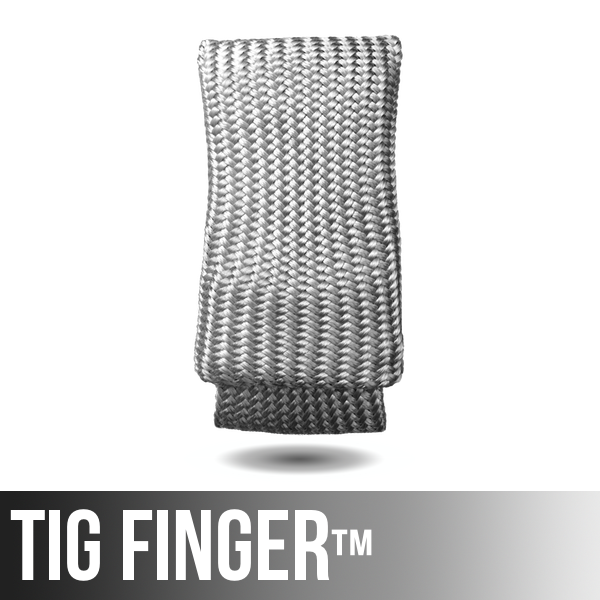View a list of products I recommend at www.amazon.com/shop/weldingtipsandtricks
Video Transcript
6011 Rods – Pros and Cons
Today I’m going to be doing a little stick welding with 6011 rods, and I’m going to be welding on AC. Let’s do it. I’ve got this little joint tacked up here. It’s two lap joints and two sides of a T joint. I’m going to weld all joints up in different positions with the 6011 rod. 6011’s very much like a 6010, a cousin of a 6010, except that you can use AC. You can’t run 6010 on AC. The good thing about 6011’s is a lot of newer inverters today, will not run a 6010, but they will run a 6011. I think it’s a very handy rod to have for when you’re in a pinch, when you’re called on to go make a weld somewhere, and they tell you, “We’ve got everything you need. Just bring your helmet.” You might do yourself a favor to bring along some 6011 in different diameters.
I’m doing a little whip and pause motion here, and that means I’m coming ahead about two electrode diameters, and then coming back about one electrode diameter. That’s typical for 6011 or 6010. You can control how much penetration or how much you cool of the puddle with our stroke here. If you’re coming way out of the puddle and back in, you can keep the puddle cool. If you just use a really small motion, you can dig and get deeper penetration.
It’s a really versatile rod. We’ll clean that one up a little bit and see what we’ve got. You get rougher ripples with a 6011. It’s not going to be as pretty as a 6013, or a 7014, or a 7018. It’s super useful for out of position welding and this is only an eighth of an inch thick, and I’m using a one eighth rod, and I’m not having any trouble. I’m going to do a couple of downhill runs, as well, on this same joint, and we’ll test it at the end. This is the T joint side, you see I’m just doing a really short whip and pause. Just pausing long enough to make sure that I don’t leave any undercut behind, because when you whip forward, sometimes you chew out some metal, and you’ve got to come back and hold the electrode in there and fill it up. That’s the two joints all wire wheeled up. T joint and lap joint.
Let’s compare that now to a 7018 arc, which is nice and smooth, really easy to see the puddle. Just a slow drag. You don’t do anything, any whip and pause with the 7018, typically. Just to get a different idea … Different rods for different applications. This slag comes off much easier, don’t really even need much of a wire wheel on there. All right. I’m at 115 to 120 amps on AC. One of the reasons I like to use AC with a 6011 is you just avoid any potential arc blow issues. Arc blows is when you weld long for a little while and that electrode starts burning off to one side, it sets up magnetic forces, and it burns off unevenly, and you really got to cram it in there to keep from under cutting and everything. On AC, you don’t get arc blow. I like it because it runs the same from start to finish. The rod starts off welding one way, and it pretty much welds the same way all the way to the end of the rod.
You notice some differences with DC, EP, when the rod heats up, toward the end of the rod it starts melting off a little differently. This is the downhill run, keeping that angle poked up in there. Push the slag back. That was the T joint. We’ll cool that off a little bit and then we’ll do the lap joint, here. Really, there’s not a whole lot of different in technique, really, you’re just watching something a little bit different.
This is a stand that I want to give a thanks to Triangle Engineering for sending me a few years ago, to help support these videos. It comes in really handy for stuff like this. Using the same rod angle, and really, right here, I’m just watching the left hand side, the shoulder of that piece, to make sure I fill it in enough, and don’t chew it off and leave a little chewed off area, or under cut there. Other than that, not doing anything different than I was on the downhill run on the T joint. The reason I’m going downhill on these joints, is just because I think this rod, that’s the benefit of it. If you’re going to do some light fabrication and all you have is a buzz box, like on two inch square tubing that’s eighth wall, being able to go downhill and zip up little gaps and things, is a big benefit. That’s due to the light slag coating on it, and the slag doesn’t want to run ahead of the arc like it does sometimes with a 6013, or other rod.
Quick test on these things. There’s nothing like a test to see if you’ve got penetration or not, especially when it’s fresh on your mind. You just saw the puddle, and then you test and you can correlate, “Okay. That looked like it was really getting in there, and it was.” Or, “That looked like it was getting in there and it wasn’t.” Here you have the downhill lap joint on the left hand side there, you can see that, little bit lack of fusion in the bottom, and the other two did much better. Cutting one section doesn’t really prove anything, but it sure does give you a little information. If you really want to prove out something, you have to cut multiple sections of a joint, and that way you can see if it was just an anomaly or that’s pretty much what it looked like throughout the joint. There’s the horizontal lap joint. No problems there on penetration. Again, this is only eighth inch wall.
Let’s talk now about welding something a little bit thicker, where you might want to go up to a thicker rod. 532 opposed to a one eighth rod. You’d think all that extra amperage and everything would penetrate deeper, and it might, sometimes. But here the one eighth rod, you can see it gets right down there in the root of the joint, whereas just the size of this rod keeps the core of the electrode, the metal part, inside. It keeps it afterheat away from the root of the joint, and sometimes you don’t get the penetration you think you’re getting just because of the diameter of the rod. I’ve got these scrap pieces laying around, some box tubing along with some base plate there, thanks JD for this stuff.
I’m doing this because it reminds me of a job I did years ago, for a friend, building a metal rack in his machine shop. When he was setting up shop in a new commercial building, he needed to get a metal rack built, really quickly. All that was onsite in the building, at the time, was an AC buzz box, a box of 532 6011’s, and a framing square, and not much else. We built a Christmas tree style metal rack with that buzz box and 532 60111’s, and actually it went together a lot better than I thought it did. It had some light rusting paint on it and that’s another good thing about 6011, it’s got such an aggressive arc, that it will dig through any of that stuff. We didn’t even have a grinder on the job. I was told, “Hey. Just show up and weld it. We got everything you need.” And that’s a song and dance we’ve all heard before. Just show up with your welding helmet. Yeah, you probably should bring some rods and bring a grinder, and whatever else to make life easy.
This might be the arc shot from that one eighth earlier, I got mixed up, but they look the same. The 532 just a bigger puddle. Things looked like they were going in there really well, on the downhill runs here, and that’s the only ones I’m gonna test, by the way, are the downhill runs. Just to see, if I got the penetration that I think I got, and it’s just always good to test stuff. An opinion can mean one thing, but a test means something else. You’re always going to get more penetration going uphill than you do downhill. That’s a rule of thumb, doesn’t matter if you’re talking about mig or stick, or tig, or whatever, because gravity pulls your puddle behind you, and lets that arc do it’s penetration up in the front of the puddle. As a rule of thumb, doesn’t matter what you’re talking about, you’re typically gonna get less penetration downhill than you will uphill.
I’m just messing around here, doing a little experimenting, bringing you along for the ride and gonna show you the test results. Probably need a little different heat on downhill as opposed to overhead. This is hot, I’m really having to jam that rod in there to eliminate undercut. It’s working out. You can see my rod angle changing here. I didn’t ever really realize that was going on. All right, we’ll get it all shined up.
The downhill runs there, look pretty decent. They look like a pretty good sized weld, but we’re gonna test them. This is a fill it weld gage, in your garage you probably never need one of these but on a shipyard, or a heavy duty commercial like power plants and everything, if you’re doing structural welds, an inspectors gonna come and check the size of your fill it welds, it’s good to have this and check them yourself so that you can verify you’ve got what you need.
If this called for a 3/16th fill it, that met the leg size, but it’s also got to meet the throat size. You can see that’s a very concave weld there. Very concave fill it weld. The other side of the fill it gage there checks the throat. We put that in there, then once ii get it held straight, you can see that it’s shy. Quite a bit shy. Doesn’t have anywhere close to the throat that a 3/16th fill it weld should have. You could just come across that thing with another downhill pass and fill in and get adequate size, but typically on a coated work, you wouldn’t be going downhill anyway, you’d be using uphill and you’d be using a low hydrogen rod. Let’s test it real quick and this is an eye opener.
The reason I say that is because there’s not a lot of thickness of that weld throat there. It’s pretty skinny compared to the thickness of the base metal. Also got a little lack of fusion in the root of the joint. Little straight line there indicates lack of fusion. The short little line I made there is what’s called the actual throat. There’s an effective throat, there’s a theoretical throat, and then there’s the actual throat. The actual throat is the shortest distance between the weld root and the face of a fill it weld. That 532 6011, because of the diameter of the flux and everything, was having a hard time getting down into the root of that joint.
Also, just laid down a really thin weld, which might be okay for certain things, but I think the take away here is there’s limitations to everything and downhill on eighth of an inch was fine, using the one eighth diameter 6011, but maybe it’s not so fine here on thicker material. That’s why I test things. All right. Let me wrap this up here with a quick summary. The reasons I like 6011, it’ll run on AC just as well as it does on DC. Sometimes you’re thrown into a situation, all you got is an AC buzz box to make something happen with, 6011 is a great rod to make something happen with.
I also like the fact they’re readily available at big box stores, tractor supply, auto supply stores, and you can get them all the way down to the 1/16th diameter. A little tiny rods. That’s good for sheet metal and it’s … But it’s also good for if you just need to make a really quick weld, and you’re popping a breaker because you don’t have a good circuit to plug into. Sometimes that 1/16th rod will just get you by. I know my buddy JD carries 6011’s with him when he goes in a plant, sometimes instead of having to roll 50 or 100 foot of lead somewhere, and only to make a 1/2 inch weld on a bracket on a conveyor belt of something that broke and it’s halting production. Sometimes he just walks in there with his little 10 pound invertor or stick welder, plugs in the wall, puts a small diameter 6011 in, makes the weld, unplugs, out of there. 6011’s in different diameters gives you options. Options are a good thing.
I would appreciate it if you would visit my store at weldmonger.com. That’s how I support these videos. Thanks for watching.







November 11, 2017 at 10:05 PM
I just want to say that I found this video of you running the 6011 rod in the different positions very helpful. Thank you Jody!
Would you also talk to the use of 6013 and 7014? And demonstrate their uses.